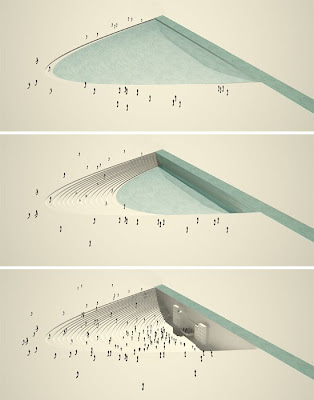Blue is the New Green – runs the headlines in last weeks NY Times blog, and not a moment too soon for that. Allison Arieff give an explanation: “A range of alternative energy technologies are available to us today; there is, however, no substitute for water. But there are new ways of thinking about water that can help us make better use of the available supply. …there are innovations, large and small, now available that would provide for systematic management and optimization of our nation’s water.”

:: image via Inhabitat
While this idea of peak-water is not news – it did spur an interesting debate. Arieff went on in the article to explain a range of strategies that aim to address the water dilemma, all of which are pretty common fodder on the landscape architectural front: Living Roofs, Living Walls, Greywater, and Rainwater Harvesting all focus around green building and sustainable sites.


:: images via NY Times
While many of the above examples ring truly green, the specific focus on blue, particularly in water conservation and stormwater strategies. Some other projects around the concept of water worthy of discussion. First, a great water diagram via a post from my buddies at Urbanarbolismo, (here’s a link to the English translation) Jordi mentions: “Recently I published an article entitled: 10 original ideas for water treatment systems, without a doubt this project: “The mysterious story of the garden that produces water” would be the idea 11. This is a project for a garden that recycles waste water for the people of Cehegin (Murcia).” The idea comes from Monica Garcia and Javier Rubio from cómo crear historias – read more about the project at their site.


:: images via Urbanarbolismo
This may strike on one of those discussions we had related to telling stories with a minimal amount of imagery… in this case simple animated graphics that layer items upon each other to give relationships. Check these interesting and simple ‘narratives’.


:: images via Urbanarbolismo
Pruned picked up a bunch of posts around water that are a fabulous cross-section. A snippet discusses the Central Arizona Project (if you’ve read Cadillac Desert you know this one)…

:: image via Pruned
…and follows up with a pairing that discusses the work Paisajes Emergentes and their second-place winning competition entry for an abandoned airport in Quito (Parque del Lago) with some amazing graphics – (be sure to click on the LONG site plan and exploded axon drawings below for sure).


And some more focused imagery:
:: images via Pruned
While static, the following series gives another ‘narrative’ which is essential in discussing process-based designs involving water. This amphitheater / urban beach / rainwater harvesting storage tank is elegant and simple in design and function.
This reminds me (albeit much more expansive and elegant) of a project I designed here in Portland (well Milwaukie, Oregon) that used the sunken amphitheater seating for additional rainwater storage in an urban plaza (i’ll post some images soon)… the scale and quality of this are great in image – and from experience there are some logisitics that would need to be grappled with for sure to pull it off. More images of all of these projects are availabile via the Flickr site for Paisajes Emergentes.
Finishing off the triad – another project from Pruned that offers some interesting images (and fantastic graphic techniques) for the Marti Mas Rivera, of Universitat Politecnica De Catalunya, Barcelona, a rainwater harvesting project for the Arabic Fortress Hill of Baza in Andalucia. Check the full post, but check these amazing pics.
eye candy offers a more simple view of an integrated rain chain via a project from David Baker + Partners Architects, showing the connection from imagery to action.
There are definitely some other interesting phenomena out there. Lisa Town mentions in her recent trip to Venice, the phenomenon of rising tide intruding into public spaces: “In the areas where piazza is at it’s lowest, which is in even outlined with lines in the paving that also used to provide an outline of the underlying cistern, the water sits in the plaza. It actually makes for beautiful pictures with the reflection of the surrounding buildings but is nevertheless an unfortunate event to see.” Read her post for more pics… I’m particularly fond of the walkways where people patiently queue up to cross the water.
Again, Lisa Town mentions the great Play Pump (see Aqueous Solutions for a reference here at L+U), which uses a merry-go-round to pump and store drinking water for use… particularly important in areas where access to fresh water may mean the difference between life and death. That’s good, clean, and from the sounds of it, Green fun.


















